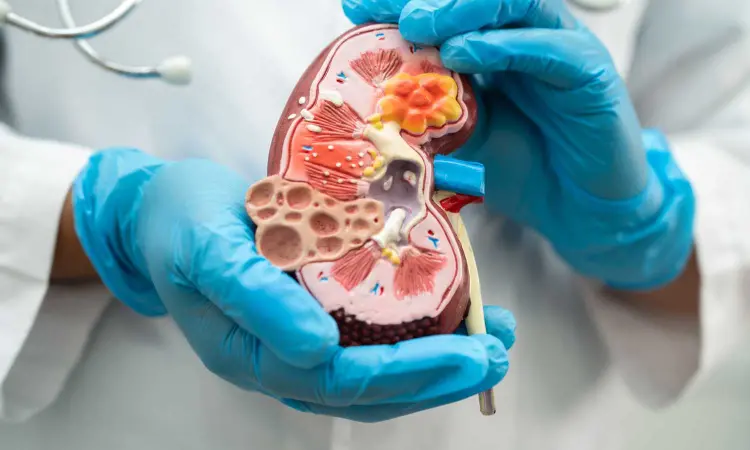- Home
- Medical news & Guidelines
- Anesthesiology
- Cardiology and CTVS
- Critical Care
- Dentistry
- Dermatology
- Diabetes and Endocrinology
- ENT
- Gastroenterology
- Medicine
- Nephrology
- Neurology
- Obstretics-Gynaecology
- Oncology
- Ophthalmology
- Orthopaedics
- Pediatrics-Neonatology
- Psychiatry
- Pulmonology
- Radiology
- Surgery
- Urology
- Laboratory Medicine
- Diet
- Nursing
- Paramedical
- Physiotherapy
- Health news
- Fact Check
- Bone Health Fact Check
- Brain Health Fact Check
- Cancer Related Fact Check
- Child Care Fact Check
- Dental and oral health fact check
- Diabetes and metabolic health fact check
- Diet and Nutrition Fact Check
- Eye and ENT Care Fact Check
- Fitness fact check
- Gut health fact check
- Heart health fact check
- Kidney health fact check
- Medical education fact check
- Men's health fact check
- Respiratory fact check
- Skin and hair care fact check
- Vaccine and Immunization fact check
- Women's health fact check
- AYUSH
- State News
- Andaman and Nicobar Islands
- Andhra Pradesh
- Arunachal Pradesh
- Assam
- Bihar
- Chandigarh
- Chattisgarh
- Dadra and Nagar Haveli
- Daman and Diu
- Delhi
- Goa
- Gujarat
- Haryana
- Himachal Pradesh
- Jammu & Kashmir
- Jharkhand
- Karnataka
- Kerala
- Ladakh
- Lakshadweep
- Madhya Pradesh
- Maharashtra
- Manipur
- Meghalaya
- Mizoram
- Nagaland
- Odisha
- Puducherry
- Punjab
- Rajasthan
- Sikkim
- Tamil Nadu
- Telangana
- Tripura
- Uttar Pradesh
- Uttrakhand
- West Bengal
- Medical Education
- Industry
Balanced crystalloid solution fluid of choice in deceased donor kidney transplantation: Lancet

Illegal Kidney Transplant
Among individuals receiving a deceased donor kidney transplant, intravenous fluid therapy with balanced crystalloid solution should be the standard-of-care as it decreases the delayed graft failure when compared to saline. The study was published in the journal The Lancet.
A significant unfavourable outcome of kidney transplants using deceased donors is delayed graft function (DGF). Patients undergoing transplants frequently receive intravenous fluids to maintain intravascular volume and enhance graft function. Although saline, which contains 0.9% sodium chloride, is routinely used, its high chloride level raises the possibility of DGF. Hence researchers from Australia and New Zealand conducted a study based on the hypothesis that a balanced low-chloride crystalloid solution (Plasma-Lyte 148) instead of saline would reduce the incidence of DGF between Jan 26, 2018, and Aug 10, 2020.
BEST-Fluids was a viable, multicenter, double-blind, randomized, controlled trial that included 16 hospitals in Australia and New Zealand and was integrated in a registry. The trial was open to adults and kids of any age getting a kidney transplant from a deceased donor. Multi-organ transplant recipients or individuals weighing less than 20 kg were both disqualified. Participants were randomly assigned (1:1) using an adaptive minimisation algorithm to intravenous balanced crystalloid solution (Plasma-Lyte 148) or saline during surgery and up until 48 h after transplantation. Identical bags were used to supply trial fluids and clinicians determined the fluid volume, rate, and time of discontinuation. The primary outcome was DGF, defined as receiving dialysis within 7 days after transplantation. All participants who consented and received a transplant were included in the intention-to-treat analysis of the primary outcome. Safety was analysed in all randomly assigned eligible participants who commenced surgery and received trial fluids, whether or not they received a transplant.
Key findings:
- Nearly 808 participants were randomly assigned to balanced crystalloid (n=404) or saline (n=404). One participant in the saline group withdrew before 7 days and was excluded, leaving 404 participants in the balanced crystalloid group and 403 in the saline group that were included in the primary analysis.
- Among the transplant recipients there were 512 [63%] males and 296 [37%] females.
- DGF occurred in 121 (30%) of 404 participants in the balanced crystalloid group versus 160 (40%) of 403 in the saline group.
- In the safety analysis, numbers of investigator-reported serious adverse events were similar in both groups, being reported in three (<1%) of 406 participants in the balanced crystalloid group versus five (1%) of 409 participants in the saline group.
Thus, When compared to saline, intravenous fluid treatment with balanced crystalloid solution decreased the incidence of DGF in patients following a deceased donor kidney transplant.
Further reading: Balanced crystalloid solution versus saline in deceased donor kidney transplantation (BEST-Fluids): a pragmatic, double-blind, randomised, controlled trial. https://doi.org/10.1016/S0140-6736(23)00642-6
BDS, MDS
Dr.Niharika Harsha B (BDS,MDS) completed her BDS from Govt Dental College, Hyderabad and MDS from Dr.NTR University of health sciences(Now Kaloji Rao University). She has 4 years of private dental practice and worked for 2 years as Consultant Oral Radiologist at a Dental Imaging Centre in Hyderabad. She worked as Research Assistant and scientific writer in the development of Oral Anti cancer screening device with her seniors. She has a deep intriguing wish in writing highly engaging, captivating and informative medical content for a wider audience. She can be contacted at editorial@medicaldialogues.in.
Dr Kamal Kant Kohli-MBBS, DTCD- a chest specialist with more than 30 years of practice and a flair for writing clinical articles, Dr Kamal Kant Kohli joined Medical Dialogues as a Chief Editor of Medical News. Besides writing articles, as an editor, he proofreads and verifies all the medical content published on Medical Dialogues including those coming from journals, studies,medical conferences,guidelines etc. Email: drkohli@medicaldialogues.in. Contact no. 011-43720751



